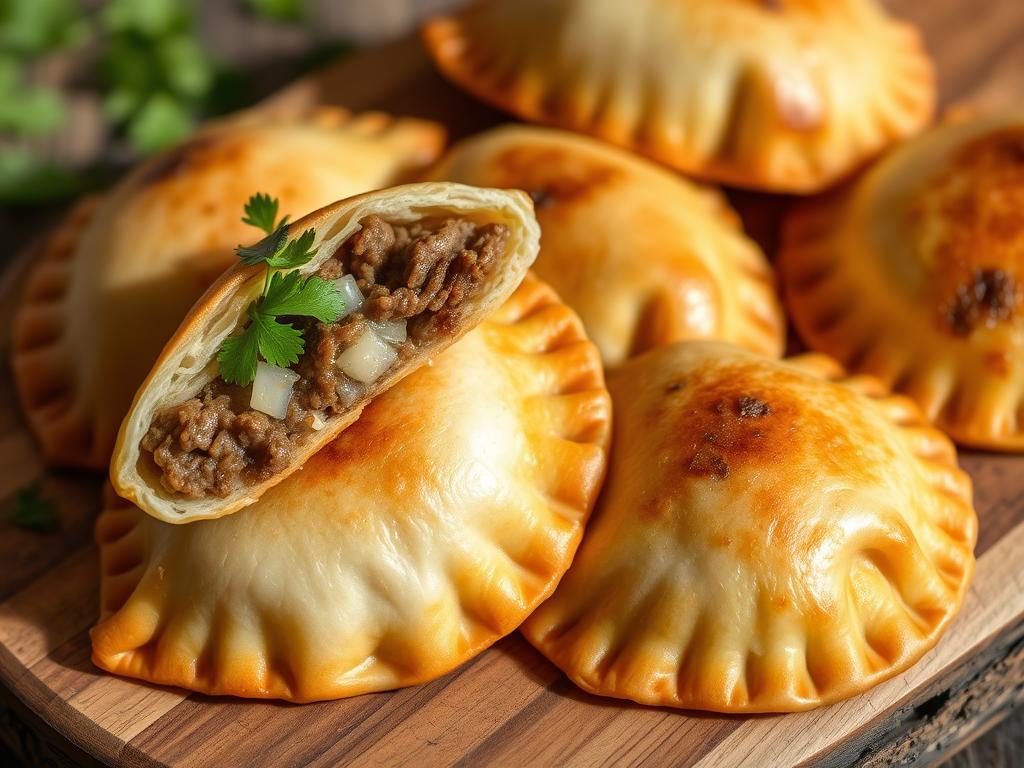Imagine taking a culinary trip to Colombia without leaving your kitchen! We’re excited to share with you our treasured recipe for authentic Colombian Empanadas, those crispy, golden pockets filled with seasoned meat and potatoes that have captured the hearts of food lovers worldwide.
These delightful treats are a staple in Colombian cuisine, and their unique flavor is a perfect blend of tradition and culture. Unlike other Latin American versions, our empanadas feature a distinctive cornmeal dough that gives them a characteristic crunch.
We’ll guide you through each step of creating these delicious empanadas, from preparing the perfect dough to achieving that ideal golden crust when frying. With our recipe, you’ll be able to bring the vibrant street food culture of Colombia right to your kitchen!
Key Takeaways
- Learn how to make authentic Colombian empanadas with a unique cornmeal dough.
- Discover the secret to achieving a crispy, golden crust when frying.
- Explore the cultural significance of empanadas in Colombian cuisine.
- Get tips on preparing the perfect filling with seasoned meat and potatoes.
- Enjoy a delicious and easy-to-make recipe perfect for parties or snacks.
The Beloved Colombian Street Food
In Colombia, empanadas are more than just a snack; they’re a cultural phenomenon. These delicious pockets of flavor have become an integral part of Colombian cuisine, enjoyed by people of all ages.
Colombian empanadas stand out due to their unique characteristics. The use of pre-cooked cornmeal dough gives them a distinct crunch when fried. The filling typically consists of a mixture of ground meat, potatoes, and spices, making them a satisfying snack.
What Makes Colombian Empanadas Unique
Colombian empanadas are distinct from other Latin American varieties primarily due to their yellow cornmeal dough and traditional deep-frying method. The dough, made from pre-cooked cornmeal or masarepa, creates a crunchy texture that’s hard to resist. The filling is also noteworthy, typically featuring a flavorful combination of ground beef or pork mixed with potatoes and seasoned with Colombian spices.
Regional Variations Across Colombia
While Colombian empanadas share a common foundation, regional variations exist across the country. Coastal regions might include seafood in their fillings, while in Bogotá, you might find empanadas with rice instead of potatoes. The size and shape can also vary, from the tiny “empanaditas de iglesia” with potato filling to larger versions stuffed with various ingredients. This diversity reflects the rich culinary landscape of Colombia.
History and Cultural Significance
The story of Colombian empanadas is one of cultural fusion, blending Spanish and indigenous influences. We see this blend in the way empanadas are made, using corn instead of wheat flour, a change that reflects the resourcefulness of Colombian cooks.
Origins of Colombian Empanadas
Colombian empanadas trace their origins back to Spain, where they were introduced during colonial times. However, Colombians transformed them by incorporating local ingredients and cooking techniques. Over time, these tasty pockets evolved to become a distinctly Colombian culinary tradition that reflects the country’s mixed heritage.
- Indigenous ingredients like corn were used instead of wheat flour.
- Local flavors and cooking techniques were incorporated into the empanadas.
Traditional Occasions for Serving
Empanadas hold special cultural significance in Colombia, often appearing at family gatherings, celebrations, and religious events. They’re not just food, but a symbol of community and sharing. You’ll find empanadas served at virtually every Colombian festival and holiday, typically enjoyed with a side of spicy ají sauce and fresh lime wedges.
- Empanadas are a staple at Colombian festivals and holidays.
- They’re often served with ají sauce and lime wedges on the side.
Essential Ingredients for Colombian Empanadas

To make authentic Colombian empanadas, you’ll need a few key ingredients that provide the characteristic flavor and texture. The process begins with preparing the cornmeal dough and the traditional filling, each requiring specific components.
For the Cornmeal Dough
The cornerstone of Colombian empanadas is the cornmeal dough, made primarily with masarepa, or pre-cooked yellow cornmeal. This ingredient is crucial for achieving the distinctive crispy exterior.
Masarepa: The Secret to Authentic Texture
Masarepa is the secret to the authentic texture of Colombian empanadas. It’s different from regular cornmeal because it’s pre-cooked, making it easier to work with and giving the empanadas their characteristic crunch.
Seasonings and Liquids
To mix with masarepa, you’ll need lukewarm water and a touch of oil, preferably vegetable or canola oil, to create a pliable dough. Adding salt and Sazón with azafran gives the dough its golden color and flavor.
For the Traditional Filling
The traditional filling of Colombian empanadas is a mix of flavors and textures, starting with a base of ground beef and pork, combined with potatoes that help bind the mixture.
Meat and Potato Base
The filling begins with sautéing ground beef and cooking potatoes until they’re tender. This mixture forms the bulk of the filling.
Vegetables and Spices
Vegetables like finely diced white onions, scallions, red bell pepper, tomatoes, and garlic are sautéed to create the aromatic base known as “hogao” or “guiso.” Fresh cilantro adds brightness, while Sazón with azafran, salt, and black pepper provide the authentic Colombian flavor.
| Ingredient | Use in Empanadas |
|---|---|
| Masarepa | Cornmeal dough |
| Ground Beef and Pork | Filling base |
| Potatoes | Binding ingredient in filling |
| Vegetables (Onions, Scallions, Bell Pepper, Tomatoes, Garlic) | Aromatic base for filling |
| Sazón with Azafran, Salt, Black Pepper | Seasoning for dough and filling |
Making Perfect Colombian Empanadas

To create authentic Colombian empanadas, we need to focus on the fundamentals: preparing the dough, crafting the filling, and sealing the empanadas. This process involves a few simple steps, but the result is a complex flavor profile that delights the palate.
Preparing the Dough
We start by preparing the dough, combining masarepa with warm water, a touch of oil, salt, and Sazón in a large bowl. Then, we knead it for about 2 minutes until it’s smooth and pliable. The texture should be moist but not sticky. After forming the dough, it’s crucial to let it rest covered with plastic wrap for about 20 minutes, allowing the cornmeal to fully hydrate and making the dough easier to work with.
Creating the Flavorful Filling
While the dough rests, we prepare the filling by first cooking potatoes in water with a bouillon tablet until tender, then draining and gently mashing them to create a binding base for our filling. The meat mixture comes together by sautéing onions, tomatoes, bell peppers, garlic, and cilantro until fragrant, then adding ground beef and pork, cooking until the mixture is relatively dry. Combining the meat mixture with the mashed potatoes creates the perfect filling consistency.
Forming and Sealing the Empanadas
To form the empanadas, we take small portions of dough (about 1½ tablespoons each), roll them into balls, and then flatten them between two pieces of plastic or paper to create thin, round discs. The key to perfect empanadas is proper sealing – after placing a tablespoon of filling in the center of each disc, fold the dough over to create a half-moon shape and firmly press the edges together, using a fork to crimp the seams for an extra-secure seal.
By following these steps and using the right ingredients, you’ll be able to create delicious Colombian empanadas that are sure to impress. The process may take some time, but the end result is well worth the effort.
| Component | Key Ingredients | Preparation Time |
|---|---|---|
| Dough | Masarepa, water, oil, salt, Sazón | 20 minutes |
| Filling | Potatoes, meat (beef and pork), onions, tomatoes, bell peppers, garlic, cilantro | 25 minutes |
| Empanada Assembly | Dough, filling | 10-15 minutes |
The Art of Frying Colombian Empanadas

The key to delicious Colombian empanadas lies in the art of frying them to perfection. Frying is a critical step that requires attention to detail, especially when it comes to oil temperature and frying techniques.
Oil Temperature and Frying Techniques
To fry Colombian empanadas, we recommend using a neutral vegetable oil with a high smoke point. Fill a heavy-bottomed pot with about 2-3 inches of oil, enough for the empanadas to float freely. The ideal oil temperature is between 350-360°F (175-182°C). If you don’t have a thermometer, test the oil by dropping a small piece of dough into it; it should sizzle and float to the surface without darkening too quickly.
Achieving the Perfect Golden Crust
Fry the empanadas in small batches of 3-4 at a time to maintain the oil temperature. Each batch takes about 2-3 minutes to cook. You’ll know they’re done when they’ve achieved a beautiful golden-brown color and float easily in the oil. After frying, transfer the empanadas to a plate lined with paper towels to absorb excess oil.
Essential Accompaniments

No Colombian empanada is complete without its traditional accompaniments, which add depth and complexity to this beloved dish. The right accompaniments can elevate your empanada experience, making it more authentic and enjoyable.
Traditional Ají Sauce Recipe
Ají sauce is a vibrant and spicy condiment that perfectly complements the rich flavors of Colombian empanadas. To make this authentic sauce, you’ll need fresh cilantro, tomatoes, onions, hot peppers, lime juice, vinegar, and a touch of oil. Simply finely chop these ingredients and mix them together, allowing the flavors to meld for at least 30 minutes. You can adjust the heat level to your liking by varying the amount and type of chili peppers used.
The resulting sauce should be bright and zesty, with a balance of acidity from the lime juice and vinegar. This ají sauce is not only delicious with empanadas but can also be used as a dip for other fried foods or as a topping for grilled meats.
Serving Suggestions
For a complete Colombian experience, serve your empanadas with ají sauce and fresh lime wedges on the side. The acidity helps balance the richness of the fried dough and savory filling. You can also pair your empanadas with other traditional Colombian sides like patacones (fried plantains) or a simple avocado salad. For a refreshing beverage, consider serving a Colombian fruit juice like lulo or guanabana.
Conclusion: Enjoying Your Homemade Colombian Empanadas
Congratulations on making authentic Colombian empanadas – a delicious journey that’s sure to become a favorite culinary tradition! You’ve successfully brought a beloved Colombian street food into your home, and we’re excited for you to enjoy the fruits of your labor.
One of the best things about making empanadas is that they’re perfect for preparing in advance. You can make a large batch and freeze the uncooked empanadas for up to 3 months, making them ideal for last-minute entertaining or quick weeknight meals. To freeze, simply arrange them on a baking sheet lined with parchment paper, freeze until solid, and then transfer to freezer bags.
Tips for Enjoying Your Empanadas: Leftover cooked empanadas can be stored in an airtight container in the refrigerator for up to 3 days. To reheat, place them on a baking sheet, spray with a little oil, and bake in a 350°F oven for about 15 minutes, or until crispy and heated through. Feel free to get creative with your fillings – chicken, cheese, or vegetarian options with beans and corn are all delicious alternatives.
We hope these Colombian empanadas bring a taste of South American street food culture to your home and inspire you to explore more of Colombia’s rich culinary heritage!
🌟 Start Your Day Right with Delicious Breakfast Cookies! 🌟
Are you tired of the same boring breakfast routine? Discover how our Breakfast Cookies can transform your mornings into a healthy and satisfying experience! Packed with nutritious ingredients, these cookies will fuel your day and keep you energized.
Don’t miss out on the chance to elevate your breakfast game—read our latest blog post now to find out how you can whip up these delightful treats in no time!
👉 **Click here to unlock the secret to a deliciously healthy breakfast today!**

